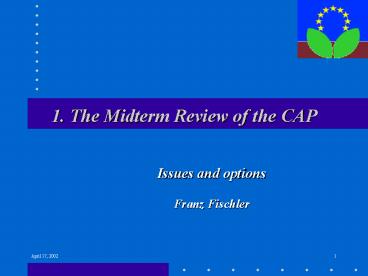1' The Midterm Review of the CAP - PowerPoint PPT Presentation
1 / 16
Title:
1' The Midterm Review of the CAP
Description:
production methods should be environmentally friendly, able to supply quality products ... what to do with the dried fodder regime? ... – PowerPoint PPT presentation
Number of Views:70
Avg rating:3.0/5.0
Title: 1' The Midterm Review of the CAP
1
1. The Midterm Review of the CAP
- Issues and options
- Franz Fischler
2
2. What do we want from the CAP?
- Where supporters and most critics of the CAP
agree - The general policy objectives of the CAP are
valid - agriculture should be competitive
- production methods should be environmentally
friendly, able to supply quality products - diversity should characterise agriculture in
order to maintain visual amenities and support
rural communities - simplicity and subsidiarity should characterise
agricultural policy - justification of support should come through the
provision of services that public expects farmers
to provide - ? But the question is how to best achieve these
objectives?
3
3. An outdated criticism
- CAP is bad from the developing world perspective
- Yet...
- EU imports most of agricultural exports from the
developing world - Core of EU agricultural exports are high
value-added products - EU net-export market share declined in every
major sector - EU market access is up in every sector
- EU export subsidies are reduced, and will
continue to do so - EU food aid is strictly linked to import demand
needs
4
4. Trade with developing countries
5
5. EU net-export market share
6
6. A contestable criticism
- CAP is bad from a WTO perspective
- Look at the facts and consistency in policy
direction - EU focus on improving policy tools under fixed
budget constraint - US focus on maximizing budget outlays with fixed
policy tools - All policies will have to meet same WTO
constraints - EU AMS to decline further under Agenda 2000
- US AMS close to ceiling,, risks exceeding it
under new farm bill
7
7. A misplaced criticism
- CAP is bad from a consumer perspective
- Yet
- consumers pay at the retail level, but price
transmission is low - cannot expect simultaneously high quality and low
price for EU food products - Someone has to pay for additional cost of quality
- income-neutral market reform improved market
balance - EU farm prices have significantly declined in
reformed sectors
8
8. EU farm price evolution
9
9. Resolving the following dilemma...
- Implications of a competitive agricultural sector
- efficiency of production ? production cost and
farm size relevant - competitiveness in world markets ? lower product
price relevant - Implications of a quality agricultural sector
- higher cost of production ? higher product price
- real demand for quality essential ? consumer has
to pay
10
10. ...could lead to different approaches
- 1. The Scrap the CAP approach
- ? The relevant policy question is WHEN to STOP
support of agriculture at the EU level - main elements
- process of gradual budgetary decline seen as main
objective - adapting CAP instruments means of meeting budget
objective - gradual re-nationalisation of agricultural policy
a variant - 2. The policy Nirvana approach
- ? The relevant policy question DOES NOT EXIST
- CAP is fine as it is
- (at least until 2006, then well see)
11
11. Our preferred approach
- CAP as the framework to balance agreed objectives
- ? The relevant policy question is NOT IF, but HOW
to continue support for EU agriculture - focus on how our policy instruments enhance
- market orientation
- environmental benefits
- food safety
- quality
- rural development
12
12. Market sectors and the MTR (a)
- Arable crops issues
- oilseeds nothing specific needed to answer the
protein question - cereals further 5 drop in intervention price
- what impact for border protection?
- how to solve the rye oversupply problem?
- what to do with level of durum wheat aid and
quality problems? - Beef sector issues
- market support system (public intervention)
already phased-out - direct aids scheme too complex - should we
simplify/decouple?
13
13. Market sectors and the MTR (b)
- Dairy policy issues
- only possibility to present options for the
post-2008 dairy regime - are short-term support price adjustments
possible? - Other market issues
- what to do with rice (market imbalance, EBA)?
- what to do with the dried fodder regime?
- proposals expected for sugar, olive oil, tobacco
in 2003 - proposals possible for wine, fruit and vegetables
in 2003
14
14. Rural development and the MTR
- Transfer of funds from first to second pillar (1A
to 1B) - how to transfer (modulation vs degressivity,
shift of measures, payment ceiling)? - how much to transfer from 1A to 1B?
- what can be absorbed under present Rural
Development rules? - What to do with additional funds?
- are present rural development instruments
sufficient? - is there scope for additional measures to promote
quality? - how to deal with co-financing?
15
15. Wider questions and the MTR
- Cross-compliance
- objective is to link support to specific minimum
obligations - which obligations advance environment, quality,
food safety? - Promoting quality
- what measures best suited to meet this objective?
- The decoupling issue
- what objective is decoupling meant to achieve?
- are there more than one ways to decouple?
- how is decoupling linked to obligations of
cross-compliance?
16
16. What to conclude?
- MTR is not a pro forma paper exercise
- Its impact extends beyond the simple production
of food - CAP objectives can neither be achieved without
policy, nor with 15 (or more) competing policies - CAP instruments need to be adjusted based on
factual analysis of what is needed to best meet
these objectives - ? The midterm review next rendezvous































